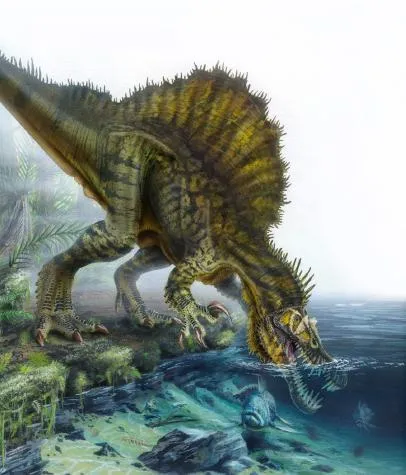Paleontologists have uncovered the remains of three species of fish-eating toothed pterosaurs in the Cretaceous-period Kem Kem beds of Morocco. From the Kem Kem beds Late Cretaceous.
Geology And Paleontology Of The Upper Cretaceous Kem Kem Group Of Eastern Morocco
The analysis of fossils from the so-called kem kem beds -- rock formations in south eastern morocco near the algerian border dating back to the cretaceous period -- shows the presence in the area.

Kem kem beds in south eastern morocco. Courville et al 1991. A Paradise For Predators. The Kem Kem beds an informal term comprise the lower Ifezouane and upper Aoufous formations.
32 for the red beds of the Continental Intercalaire cropping out in South Eastern Morocco along the border with Algeria Figure 1. A new genus and species of edentulous pterodactyloid pterosaur with a distinctive partial rostrum from the mid-Cretaceous AlbianCenomanian Kem Kem beds of southeast Morocco is described. They comprise a 150200 m thick sequence of fluvial siltstones and sandstones divided informally into lower and upper units 1 2 Figure 2.
Fragmentary remains predominantly teeth and jaw tips represent several kinds of pterosaur although only one species the ornithocheirid Coloborhynchus moroccensis has been named. The Kem Kem Beds in southeastern Morocco were once full of a variety of prehistoric life which included dinosaurs and other land reptiles flying pterosaurs sharks and fish. The likely Cenomanian-age Upper Cretaceous Kem Kem beds are exposed along the face of a limestone-capped escarpment extending some 250 km in length in southeastern Morocco.
Fragmentary remains predominantly teeth and jaw tips represent several kinds of pterosaur although only one species the ornithocheirid Coloborhynchus moroccensis has been named. Anhanguera soaring the skies over the Kem Kem with. The Kem Kem Beds.
DUTHEIL Abstract A new fish fauna from the Upper Cretaceous continental formation of southeastern Morocco is. They comprise a 150200 m thick sequence of fluvial siltstones and sandstones divided informally into lower and upper units 12 Figure 2. The term Kem Kem beds was introduced by Sereno et al.
Lamanna and Hase gawa 2014. Cavin et al 2010. A new genus and species Xericeps curvirostris gen.
In South Eastern Morocco outcrops of the Kem Kem. The analysis of fossils from the so-called kem kem beds -- rock formations in south eastern morocco near the algerian border dating back to the cretaceous period -- shows the presence in the area. Lectors in south-eastern Morocco from predominantly red continental sandstones which are known as the Kem Kem beds Sereno et al 1996.
The Kem Kem region in southeastern Morocco is one of the most famous areas in North Africa to collect fossils attracting both amateur and professional paleontologists as well as local collectors and fossil dealers Russell 1996. The likely Cenomanian-age Upper Cretaceous Kem Kem beds are exposed along the face of a limestone-capped escarpment extending some 250 km in length in southeastern Morocco Figure 1They comprise a 150200 m thick sequence of fluvial siltstones and sandstones divided informally into lower and upper units Figure 2. Nov is erected for a highly distinctive pterosaur mandible from the mid-Cretaceous Albian to lower Cenomanian Kem Kem beds of south east Morocco.
Recent examination of bones of terrestrial fauna mostly dinosaurs form the middle cretaceous kem-kem beds albian-late cenomanian of southeast morocco identified several distinctive bioerosional traces surface scratches bite marks up to 10cm long and borings in the form of channels and oval shaped chambers 5mm diameter from. Direct lateral equivalents to the Kem Kem occur in Algeria eg Gara Samani 33. Cenomanian of southeastern Morocco Didier B.
Both formations can be traced for approximately 360 km from Zguilma in the south west to Goulmima in. The fossils in this polish are from the Late Cretaceous Period 112-97 million years ago. This polish includes dinosaur reptile shark and fish fossils.
While there were many dangerous destinations on ancient planet Earth one such primeval site now stands head and shoulders above the rest when it comes to its proliferation of giant dinosaur fossils the Kem Kem beds of southeastern Morocco. Mannion and Barrett 2013. Thats according to a new paper in ZooKeys which analyzed fossils from an area in southeastern Morocco also known as the Kem Kem beds.
The Kem Kem beds in South Eastern Morocco contain a rich early Upper or possibly late Lower Cretaceous vertebrate assemblage. The Kem Kem beds in South Eastern Morocco contain a rich early Upper or possibly late Lower Cretaceous vertebrate assemblage. The analysis of fossils from the so-called Kem Kem beds rock formations in south eastern Morocco near the Algerian border dating back to the Cretaceous period shows the presence in the.
Its arid soils are well known for an abundance of large predator fossils discovered there over the decades including. The likely Cenomanian-age Upper Cretaceous Kem Kem beds are exposed along the face of a limestone-capped escarpment extending some 250 km in length in southeastern Morocco 12 Figure 1. The taxon is assigned to Chaoyangopteridae based upon its edentulous jaws elongate rostrum and slightly concave dorsal outline.
Ninety-five million years ago in what is now southeastern Morocco giant predators ruled the land known today as the Kem Kem fossil beds Riley Black. The new taxon is referred to Azhdarchoidea based on the absence of teeth slenderness of its mandible with sulcate occlusal surface presence on the. These strata are generally considered to be between Albian and Cen-omanian in age because they are conformably overlain by limestones of late Cenomanian age Neolobites vibrayeanus Zone.
100 million years ago Earth was a terrifying place.

Localities Of The Kem Kem Beds Surrounding The Region Of Erfoud And Download Scientific Diagram
Komentar